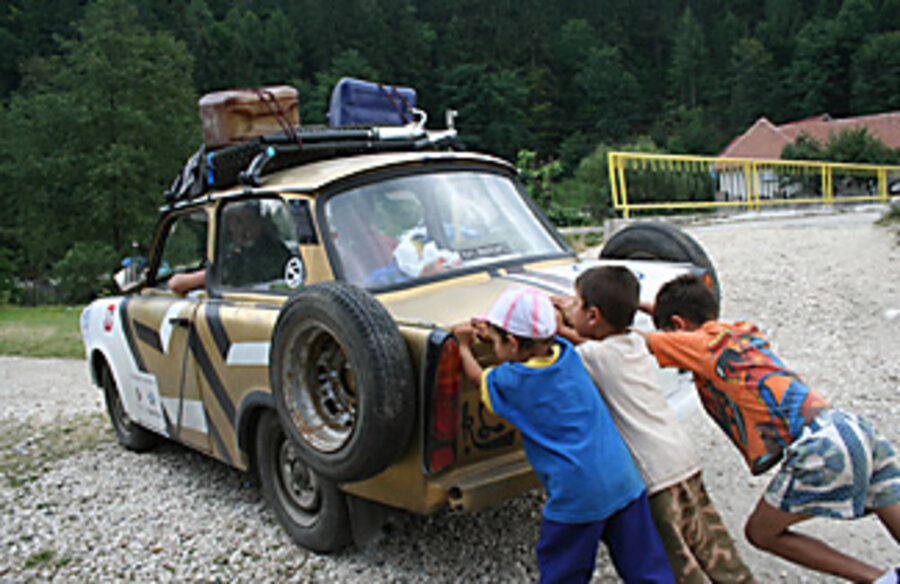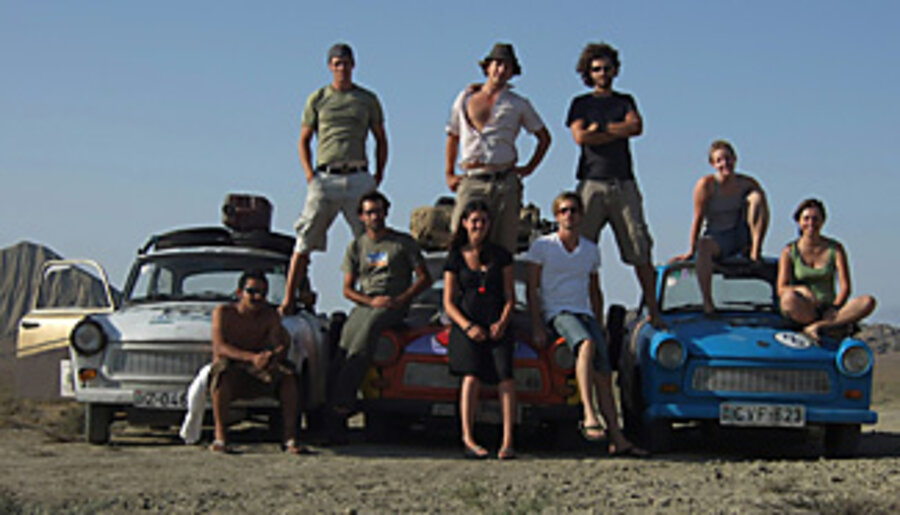On the road – from Germany to Cambodia – in a communist jalopy
Loading...
| Bangkok, Thailand
Move over, Herbie; here come the new stars of overachieving motorized underdogs. Hear them roar! OK, cough, wheeze, and sputter.
Meet Ziggy, Fez, and Dante – intrepid globetrotters, all three. Well, strictly speaking, only two remain: Dante gave up the ghost in Laos.
The decrepit champs are Trabants – "the worst car of all time" as autophiles label the infamous Soviet-era rattletrap; or "a piece of junk," as disgruntled owners used to put it across the former Soviet bloc, where the vehicle was once ubiquitous.
Yet a half century after its unveiling and two decades after its production ceased, the much-maligned car has finally proved its mettle.
Ziggy and Fez, with Dante an honorary also-ran, just completed a punishing, six-month transcontinental journey, from Germany to Cambodia, in a feat rivaling the adventures of Marco Polo. (Well ... in distance covered.)
The lowly auto owes its new prestige to Trabant Trek – an expedition meant to raise money for street kids in Cambodia. The worthy humanitarian cause also came with an automotive benefit – helping the derided little car prove that it could.
The team of four Americans and four Europeans (from England, Spain, and Hungary) drove their long-suffering jalopies across Central Europe to Turkey, then across Central Asia, on through Siberia, Mongolia, and China before limping wearily, via Laos and Thailand, into Cambodia in February.
It took them 173 days, 16,000 miles ,and countless breakdowns.
"The stress of driving in this car," admits John Drury, a linchpin of the expedition, made him constantly want to quit. "My knees are up here touching the steering wheel," explains the 6-foot, 3-inch bartender, from Bethesda, Md., as he squeezes into the tubby little driver's seat behind a plastic toy-like wheel. He faces a jittery odometer and three plastic switches.
Then again, he adds, you can just knock your seat back and drop into an exhausted sleep – in the Gobi Desert, say.
Mr. Drury and Tony Perez, a teammate from Virginia, were recently in Bangkok for a visit before driving back to Cambodia, where a local artist wants to convert the Trabants into exhibits.
Inviting a reporter along for a joyride, Drury exclaims, "Let's roll!" only to discover that the gas has evaporated from the unsealed tanks. Wearily the Americans leg it to a gas station.
On the road, the Trabants, bearing spare tires like panniers, are instant celebrities. Motorists flash thumbs up signs. Pedestrians tap the cars with bemused curiosity. Tourists snap pictures of the weird contraptions.
Fez's right door is pulled shut with a bungee cord tied to a seatbelt buckle. Windshield wipers on both cars expired in Siberia; you lean out and wipe manually. In blue Fez (named after a "That '70s Show" character), the foot brake no longer works. To slow down, Mr. Perez, an auto mechanic, yanks on the handbrake. (Fortunately, a Trabant can't get past 50 m.p.h.)
Chauffeuring silver-gold Ziggy (named after Ziggy Stardust), Drury tries a shortcut with an illegal U-turn. He creates a massive jam. Thai drivers in Toyotas and Chevrolets react ... delightedly. Even traffic cops find it hilarious.
"See what I mean?" Drury laments. "No one is taking us seriously."
The only time they got a ticket, he says, was in Mongolia – for not wearing seatbelts. That's because they'd cut them off for use as towropes.
• • •
Launched in 1957 as communist East Germany's answer to the Volkswagen Beetle, the Trabant a bare essentials-only design, was left unimproved until production stopped (after 3 million cars) in 1991, with the end of communism. Boasting a body built from cotton waste-reinforced plastic (Duroplast) and a two-stroke, 26 hp. engine, the Trabant rattles and shudders like a Soviet washing machine.
"I get kind of giddy whenever I see one," says John Lovejoy, the American who masterminded Trabant Trek after volunteering with street kids in Cambodia. He first saw a Trabant in 1989, just as the Berlin Wall was coming down – literally. Taken by his father, a US Army officer stationed in West Germany, to witness the dismantling of the iconic barrier, Lovejoy, then 10, peered through holes in the wall and was captivated.
"Everything was gray [on the other side] – the houses, the streets, people's clothes," he recalls. "But I saw these spots of color."
Trabants, yes: They came in off-white, smoky-gray and faded blue.
Mr. Lovejoy became a "Trabi" aficionado. In 2006, after his attempt to import a Trabant to the US foundered, he recruited Drury, a high school friend, for a road trip across Europe. They bought an old specimen for $60 in Hungary and covered the 450 miles from Budapest to Munich in about a week. (That Trabant later expired in Paris.)
Last year, on the Trabant's 50th anniversary, they hatched the transcontinental expedition-cum-fundraiser. Joined by six others they'd met on backpacking trips in Southeast Asia, Trabant Trek set out last July 15 from Zwickau, Germany, where the vehicle was manufactured.
"This trip," they promised well-wishers, "is going to blow your mind!"
But a carburetor blew a gasket first, near Dracula's Castle in Romania.
• • •
Trabant Trek hit the road well prepared. Drury forgot the road maps, but there were full engines and complete gear boxes in the trunks. They'd need them – as well as spare parts scavenged and improvised from junk en route.
On the 13,000 foot passes of Central Asia's Pamir Mountains, they lugged their backpacks, to unburden their vehicles for the uphill crawl.
"In Tajikistan, we broke down every 36 kilometers," Perez says.
At an unmarked border crossing between warring Armenia and Azerbaijan, they stumbled into a noman's land guarded by Armenian soldiers. Amused by their smoke-belching relics, the guards invited the trespassers to tea. Georgian border guards, meanwhile, wanted to turn them back for attempted smuggling – of the 20 gallons of motor oil they carried to mix with the gas in fill ups. In Batumi, on the Black Sea, Lovejoy, and three other Trabanteers went looking for an ATM. "Instead," he recalls, "[we] found a minister's son, his bodyguard, and [the country's] number-one ballroom dancer."
On the steppe, a horse began racing the cars. "It was running alongside a good while, looking at us," Perez says. "That was weird."
In the frozen Gobi Desert, they followed the sun and railroad lines for direction, looking "feral, to say the least," after weeks without showering. Their breath froze on the windshield, and exhaust fumes were pumped into the car by the primitive heater. "When our eyes started burning, we knew it was time to stop," Perez recalls.
When Ziggy came to land nose-first in a sand dune, with leaf springs split over wheels, it was towed to the nearest hamlet by camels.
The group spent Christmas in Laos installing new cylinders flown in from Budapest.
On Feb. 8, Trabant Trek reached Cambodia – three months behind schedule. Though their odd-looking cars were attacked by incensed cows outside Sihanoukville, Team Trabant received a hero's welcome from kids at the M'Lop Tapang day center there and the Mith Samlanh outreach in Phnom Penh.
• • •
Epilogue: The trek has raised $30,000 from Internet donations for the children's centers. But, on the return trip from Bangkok to Sihanoukville, Fez joined Dante in Trabant heaven, expiring just across the Thai border. Drury and Perez left the car on the roadside, driving off in Ziggy.
"I saw a farmer eyeing up [Fez] as we were leaving," Drury says. "Maybe he'll convert it into a plow or tractor."






